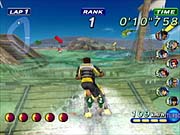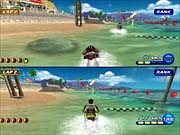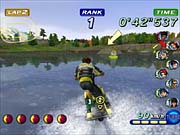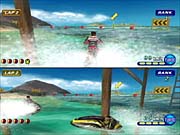Wave Race: Blue Storm Preview
We take a look at the Japanese version of Wave Race: Blue Storm.

Wave Race 64 was regarded by many as one of the finest racing games to grace the Nintendo 64 because of its excellent control, track design, and wave physics. Hoping to capitalize on Wave Race's popularity in time for the GameCube launch in both Japan and the US, Nintendo handed development honors over to its American teams at NST (Nintendo Software Technology) to create Wave Race: Blue Storm. Blue Storm might not be the sequel that many expected, due to its lack of completely new tracks, but instead, it offers a series of minor refinements and graphical upgrades to take advantage of Nintendo's new hardware. With that in mind, fans of Wave Race 64 can expect a mix of the old and new when Wave Race: Blue Storm launches with the GameCube in November.

Upon starting the game, you're immediately treated to some of the water effects as ripples gently glide over the Wave Race: Blue Storm logo, slightly distorting it. Then the main menu appears, offering the typical assortment of options to select from, such as championship, time attack, score attack, multiplayer, free run, and training. In championship mode, you compete in three different circuits, all of which have a different number of tracks and varying degrees of difficulty, with the last circuit containing all seven courses and the hardest difficulty setting. To move from one circuit to the next, you must accumulate enough points to take a cumulative first, second, or third place on the preceding circuit. Time attack essentially functions as a practice mode and lets you run through the same courses as in the championship mode without any opponents--needless to say, it becomes very useful in the later circuits. Score attack also uses the same courses as in the championship mode, but the buoys have been replaced with circular rings that give you points as you pass through them. Multiplayer lets up to four players duke it out for jet-skiing supremacy on any course in the game. Free run gives you the chance to explore an entire course without the pressure of time limits or scores, which is helpful for discovering shortcuts. Lastly, the training mode runs you through all of the tricks so that you can perform them properly during a race. Fans of Wave Race 64 will be happy to know that the number of tricks has increased, and some of them are pretty spectacular if not completely impractical.
After selecting one of the modes, you can choose from a list of eight riders, which includes faces from the old Wave Race 64 crew, as well as some new faces like Ricky Winterborn from the Nintendo 64 snowboarding game, 1080. Each rider has a different set of attributes and skills that makes him or her better suited for certain types of courses. Ryota Hayami is the most balanced rider in the game, with average ratings in all of the skill categories, making him a solid choice for beginners. If you're looking for a rider with better handling for those tight turns, you might want to try someone like Nigel Carver, who has the best handling skills of all the riders. In addition to rider stats, there are also stats for the Jet Ski itself, which can be found by tapping the Z trigger button on a specific rider. Two sliders appear in this particular menu that let you adjust the preferences for top speed vs. acceleration and grip vs. slip. It's also possible to change the color of the rider's clothes in this menu by selecting one of four different colors.
Surf Watch

The one factor that can determine the outcome of a race is weather, and this is especially apparent in the championship mode, which lets you select the weather for the first few courses before randomizing it. This is helpful to know because if you're not placing well on a particular course, you may find that changing the weather conditions can make a rather drastic difference in your race performance. When the sun is out and shining bright, the seas are calm and easy to navigate, but there are occasions when an object can disrupt the calm waters. In the hard circuit version of Cool Ocean, two enormous pieces of ice break off one of the surrounding glaciers, producing an enormous wave that almost completely clouds your vision. Similarly, in City Harbor, large metal crates drop down from nearby cargo vessels, but unlike the glaciers, the crates are partially above water and can be used as ramps. You have to keep an eye out for these objects even in the best of weather conditions.

Stormy weather is obviously the most difficult to race in for a number of reasons: Low clouds shorten your view distance, rain droplets bombard you, and the water becomes so choppy that making basic turns can be surprisingly difficult. Treacherous weather also produces some breathtaking visuals--there's nothing quite like racing on the Southern Island course with ominous dark clouds, heavy downpour, and lighting strikes off in the distant ocean, or cruising on the crystal-clear water of Aspen Lake as a thick layer of fog burns off.
Despite the excellent wave and weather effects, parts of Blue Storm's environments have a simple look and don't exactly push the GameCube's power to its limits. This is especially obvious when you see a course before the race, when the swooping camera shows the course's lifeless and flat course-side details. However, there are times when the scenery comes to life, like in Dolphin Park, with its assortment of aquatic creatures swimming beneath your feet, or in Cool Ocean, where an army of penguins plunge into the ice-cold waters.
As for Wave Race: Blue Storm's control, the learning curve is steeper than it was in Wave Race 64. Obviously some riders have different attributes that can change the controls, but no matter which rider you select, it's easy to spin out and lose control. Additionally, racing in the pack is a challenge because the wake coming from other riders can disrupt even the slightest turning movement. After some time, the control is easier to deal with, but it still doesn't seem quite as smooth as the control in Wave Race 64.
The weather and wave effects have been drastically improved, while the environments and actual rider models have received only a moderate increase in polygon count. The learning curve for controls is more pronounced, mainly because wave behavior is so much more realistic this time around. Wave Race: Blue Storm is scheduled to arrive this November alongside the GameCube launch.
Got a news tip or want to contact us directly? Email news@gamespot.com
Join the conversation